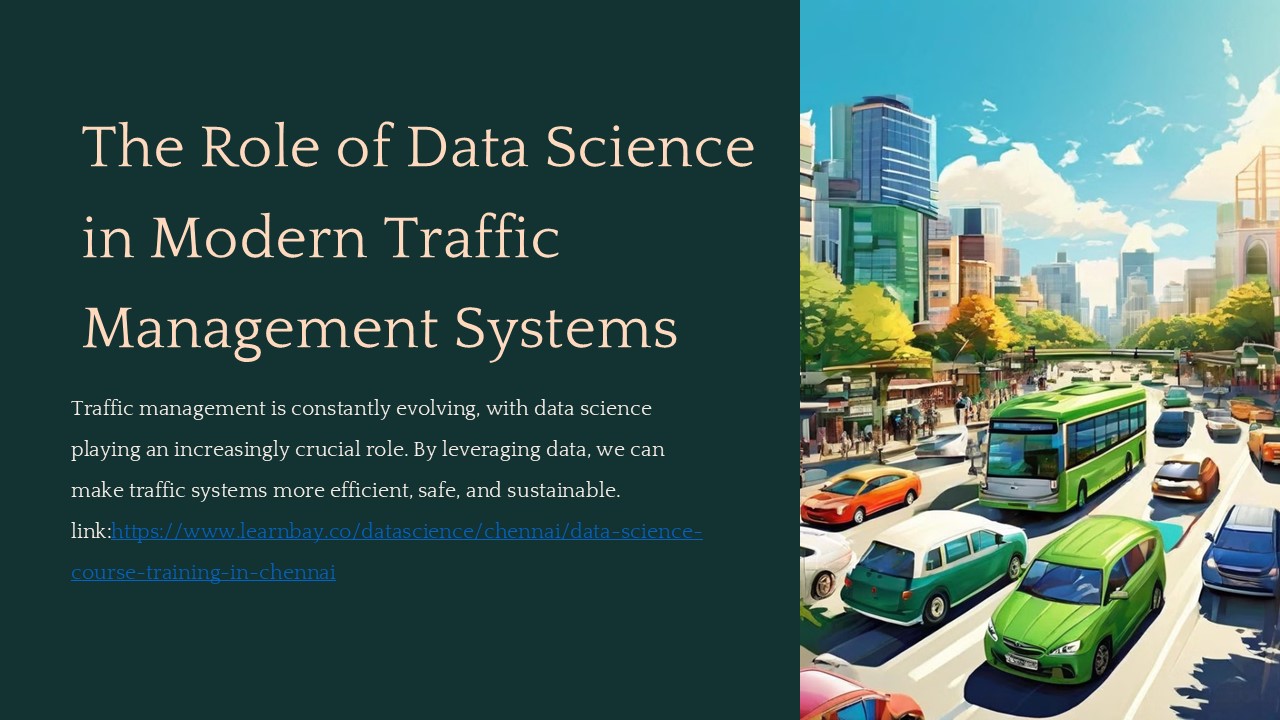The Role of Data Science in Modern Traffic Management Systems - PowerPoint PPT Presentation
Title:
The Role of Data Science in Modern Traffic Management Systems
Description:
Data science plays a crucial role in modern traffic management by analyzing real-time data to optimize traffic flow, reduce congestion, and enhance road safety. Through predictive analytics and machine learning, these systems adapt to dynamic conditions, making urban transportation smarter and more efficient. – PowerPoint PPT presentation
Number of Views:0
Date added: 14 August 2024
Slides: 9
Provided by:
dboss
Category:
How To, Education & Training
Tags:
Title: The Role of Data Science in Modern Traffic Management Systems
1
The Role of Data Science in Modern Traffic
Management Systems
Traffic management is constantly evolving, with
data science playing an increasingly crucial
role. By leveraging data, we can make traffic
systems more efficient, safe, and
sustainable.linkhttps//www.learnbay.co/datascie
nce/chennai/data-science-course-training-in-chenna
i
2
Challenges in Traditional Traffic Management
Static Solutions
Limited Data
1
2
Traditional traffic lights rely on fixed timing
cycles, often inefficient in dynamic conditions.
Traditional systems rely on limited sensor data,
leading to poor understanding of traffic flow.
Reactive Measures
Lack of Integration
3
4
Traditional methods often respond to congestion
after it occurs, lacking proactive measures.
Data silos exist between different agencies,
hindering comprehensive analysis.
3
Data Collection and Monitoring Techniques
Traffic Sensors
Mobile Device Data
Social Media
Sensors collect data on traffic flow, speed, and
congestion levels.
Smartphone location data provides insights into
travel patterns and congestion.
Social media posts and tweets provide real-time
information about accidents and closures.
- Loop detectors
- GPS signals
- Traffic updates
- Cameras
- Cellular network data
- Incident reports
- GPS tracking
4
Data Analysis and Predictive Modeling
Traffic Forecasting
Incident Detection
Predictive models estimate future traffic
conditions based on historical data and real-time
inputs.
Algorithms identify anomalies in traffic patterns
to detect accidents or road closures.
Congestion Analysis
Route Optimization
Models pinpoint areas prone to congestion and
identify factors contributing to delays.
Algorithms suggest optimal routes based on
real-time traffic conditions and predicted
congestion.
5
Optimizing Traffic Signal Timing and Coordination
Data Collection
1
Sensors gather real-time data on traffic flow and
congestion.
Data Analysis
2
Algorithms analyze traffic patterns and identify
areas for optimization.
Signal Timing Adjustment
3
Traffic lights are dynamically adjusted to
optimize traffic flow based on real-time
conditions.
Performance Evaluation
4
Traffic flow and congestion levels are
continuously monitored to refine signal timing.
6
Intelligent Traffic Routing and Navigation
Real-Time Traffic Data
Navigation apps access real-time traffic data
from various sources, including sensors and
mobile devices.
Route Optimization
Algorithms calculate optimal routes based on
real-time traffic conditions and congestion
levels.
Dynamic Route Guidance
Users receive real-time updates on traffic
conditions and rerouting suggestions to avoid
delays.
Congestion Mitigation
Intelligent routing systems distribute traffic
flow to minimize congestion and optimize
efficiency.
7
Integrating Data Science with IoT and Connected
Vehicles
Vehicle-to-Infrastructure (V2I)
Vehicle-to-Vehicle (V2V)
Connected vehicles communicate with traffic
infrastructure to share real-time data, enabling
dynamic traffic management.
Vehicles exchange information about their
location, speed, and intentions, facilitating
safer and smoother driving.
Data Analytics and Cloud Computing
Advanced Traffic Management Systems
Traffic data is processed and analyzed in the
cloud, enabling large-scale data analysis and
real-time insights.
Data from connected vehicles and infrastructure
enables more efficient traffic control, routing,
and incident response.
8
The Future of Data-Driven Traffic Management
Personalized Travel Planning
Tailored routes and schedules based on individual
preferences and real-time conditions.
Autonomous Vehicle Integration
Seamless integration of self-driving cars into
traffic management systems for enhanced
efficiency and safety.
Smart City Applications
Traffic data combined with other urban data to
optimize urban planning and resource allocation.
Sustainable Mobility Solutions
Data-driven approaches to reduce congestion,
improve fuel efficiency, and promote sustainable
transportation options.































